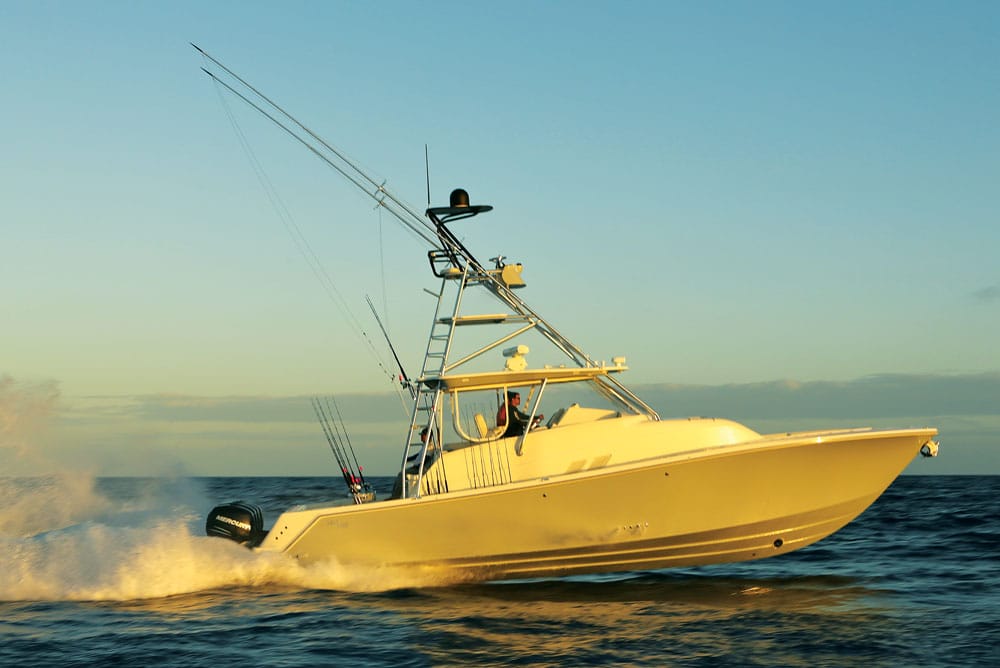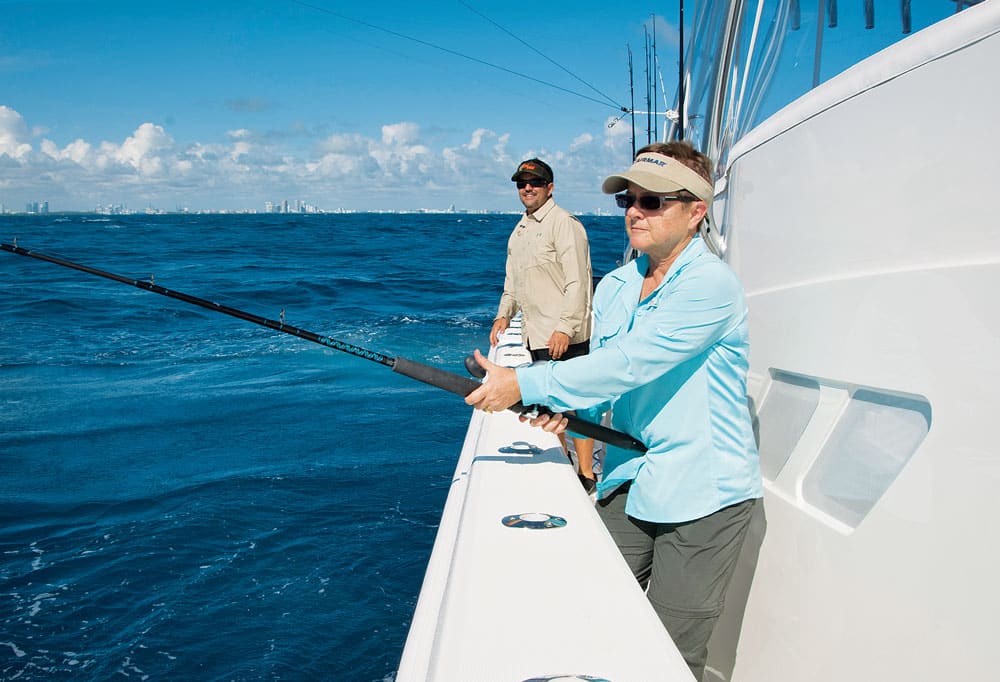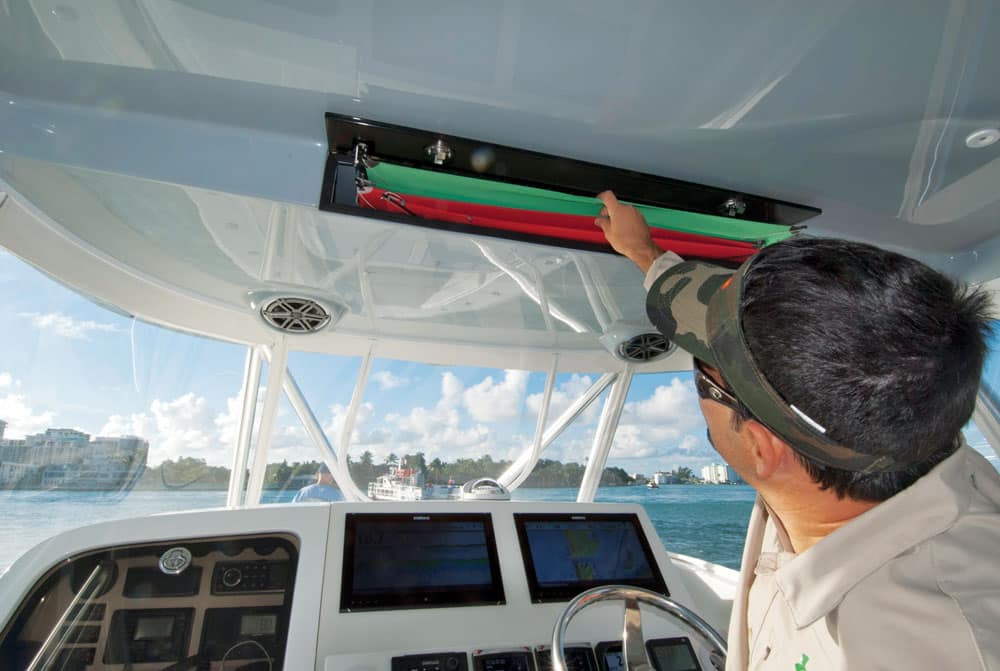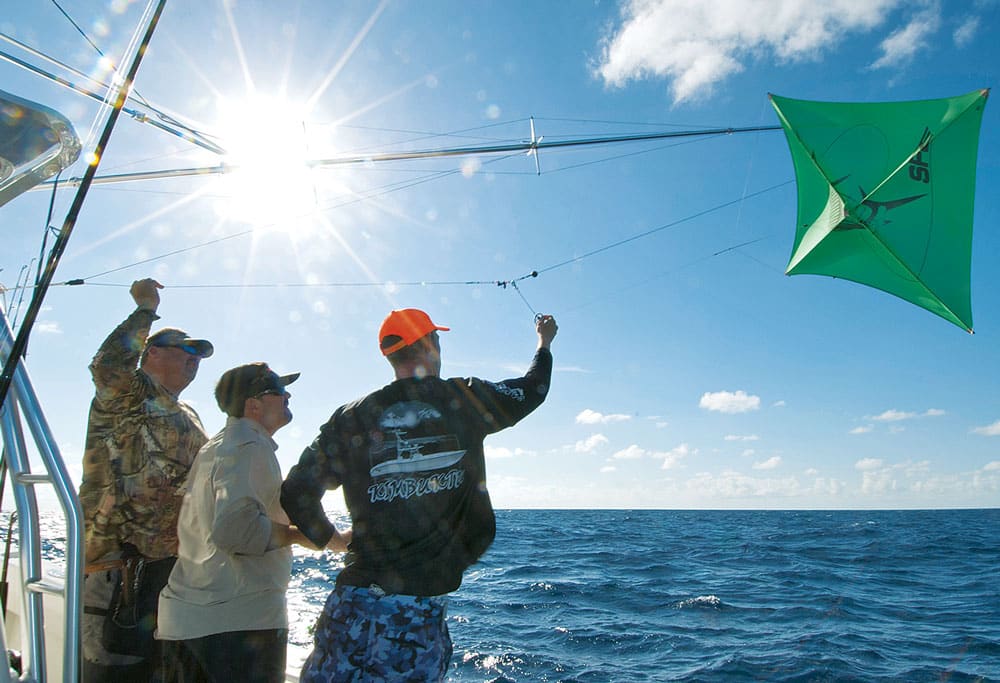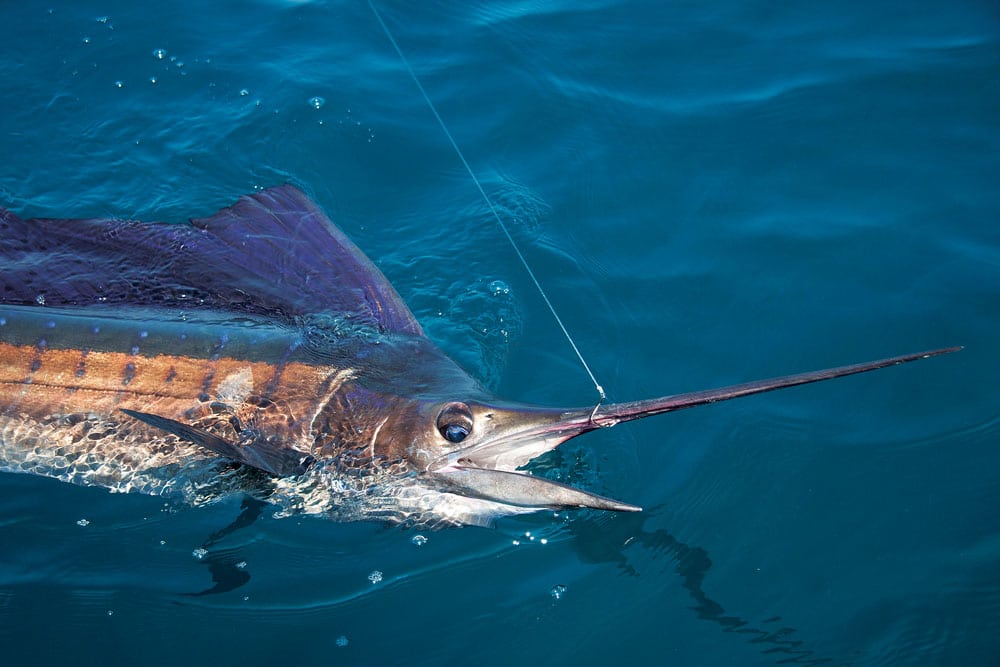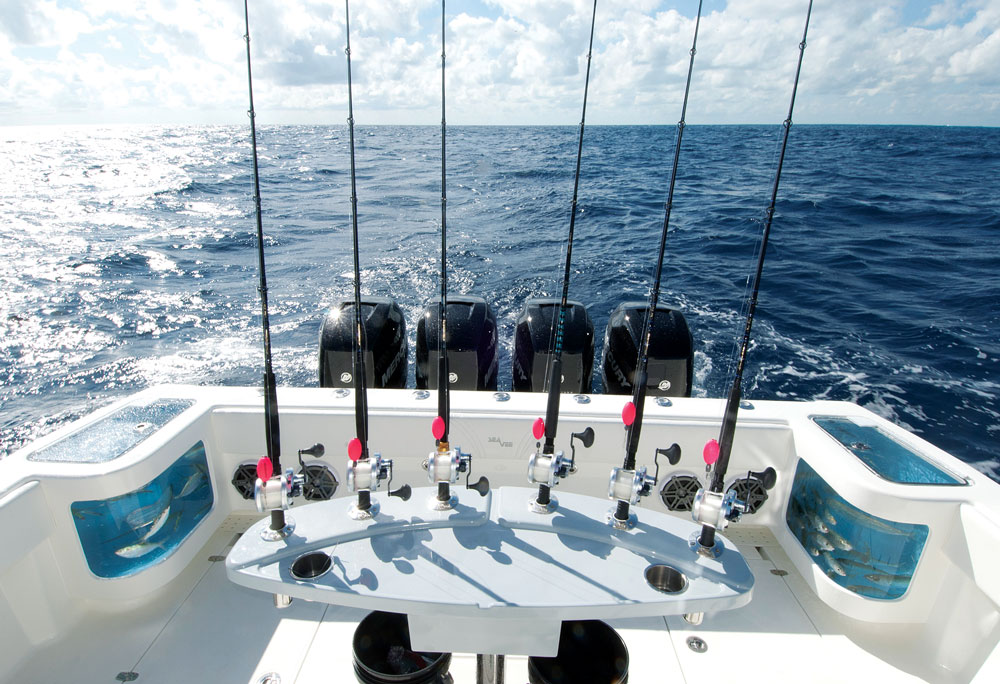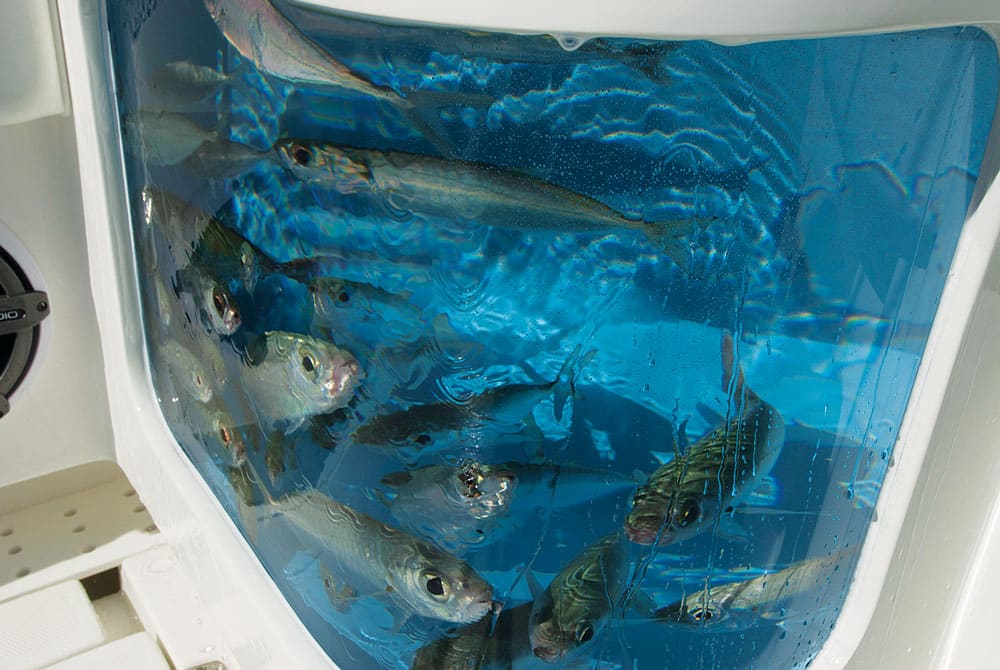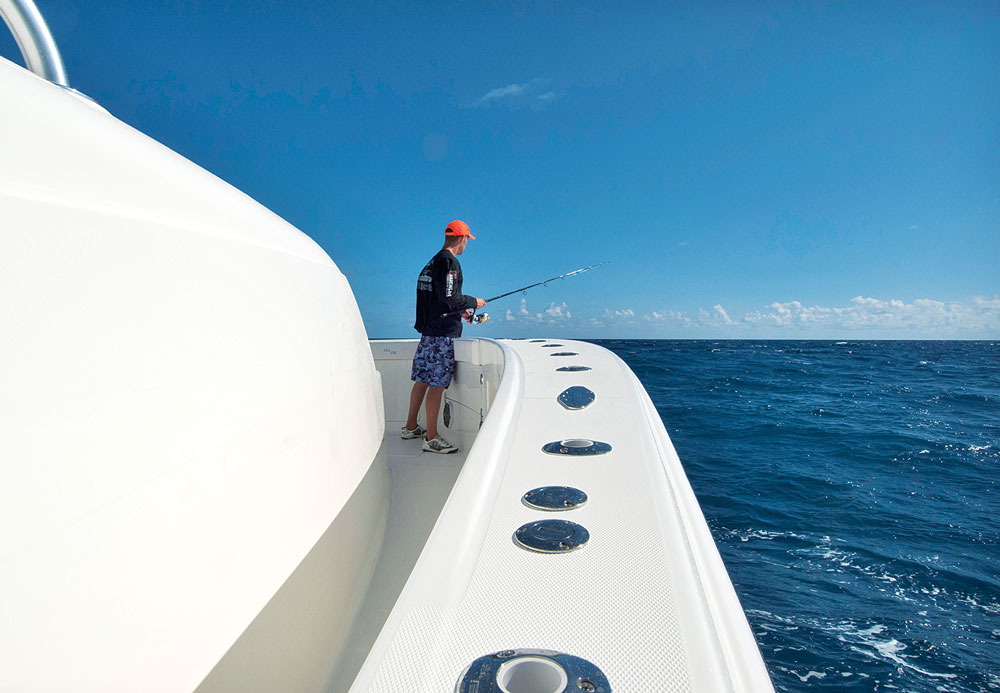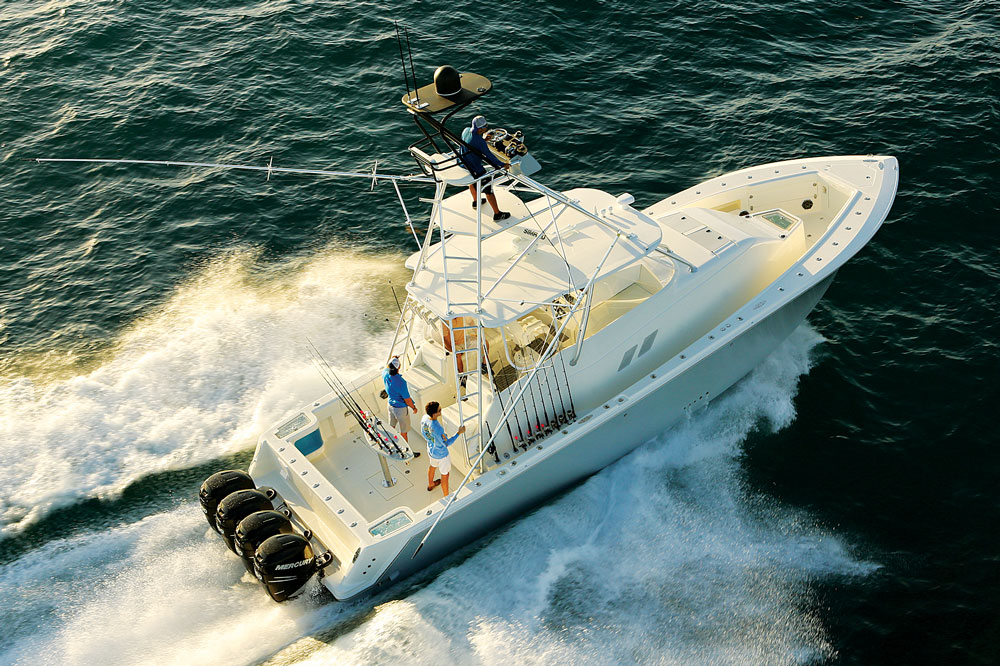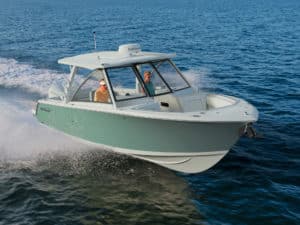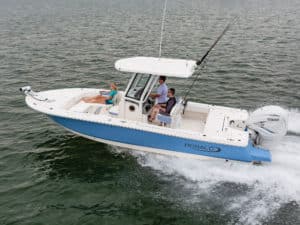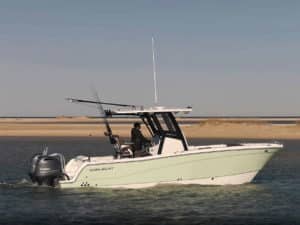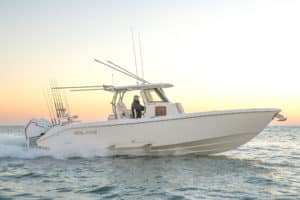From the moment I boarded the SeaVee 430 Fish-Around one sunny South Florida day this past December — using the convenient molded-in step near the base of the tower ladder — I knew this sailfishing trip would be special. SeaVee designed this unique vessel for anglers just like me.
“Our customer loves the ability to fish an open platform,” SeaVee co-owner Ariel Pared told me as we headed out Haulover Inlet off North Miami. “But he’s getting a little older and wants more comfort.
“We also built it for people coming from bigger boats, wanting a vessel they could run themselves, who are looking for less maintenance and more fishability.”
SeaVee marketing director John Caballero coined the perfect phrase for what the 430 delivers: pampered hard-core fishing.
Vessel Underway
SeaVee pulled the best aspects of a center-console — including complete 360-degree, level-deck fishing space plus an easy pass-around design at the transom — with the creature comforts of an express. Combining such qualities while reducing the inherent trade-offs was a steep challenge, but SeaVee, with its serious fishing pedigree, has strongly scored.
The seas off Miami heaped up as we began the run offshore. Capt. Dean Panos (doubledcharters.com) negotiated the slop from the tower well above as our crew took positions in the cockpit. This was a shakedown cruise and prefishing day for the 43’s first tournament, the SeaVee-sponsored Sailfish Kickoff, Dec. 4-7.
Panos advanced the throttles on the quad Mercury 300 Verados, heading south toward Fowey Light. The 43 sliced the 3- to 5-foot seas and brought its 12 tons to bear on wave crests. Confused seas made the way challenging, but even with the rare thump, the vessel felt solid, and I was able to actually sit comfortably in the bridge-deck area.
I did quickly discover my favorite perch: a small leaning post/bolster just to the port side of the captain’s chair, which is on centerline.
Fishing Setup
Panos idled the Fish-Around into position as our crew deployed six lines from two kites. The electric kite reels plugged into outlets at the base of the bridge deck. As Pared and his crew discussed the best kite setup for this maiden voyage, they also conceived a rod-holder extension to perfectly package the kite rod, reel and outrigger lines.
Twin 48-gallon livewells in the aft corners kept goggle eyes and threadfin herring separate. The curved-glass-front livewells could be classified as works of fiberglass art, employing about six molds to build. The glass lies on the inside of the well so that the water pressure naturally enhances the seal. SeaVee also thought to put a toe kick beneath the well for anglers fighting fish astern.
Pared put live-chum baits in the 45-gallon well at the bow. (A fourth well — holding 70 gallons — can replace the insulated storage box in the cockpit sole.)
The drift was flawless, and despite the rough seas, I could easily stand without a handhold as the boat rolled under me.
Bonito pestered the baits at first. I took the first hookup and easily passed the rod around the outboards as the fish changed directions. At the port aft corner, the coaming pad hit me high on the thighs — still comfortable for me, even though I’m shorter than most anglers. Gunwale height should hit the lower to midthigh of the average fisherman.
Sailfish Calling
With all lines in, Panos was about to run when he spotted a cruising sailfish that ate one of our bait discards. Four crew members grabbed already prepared spinning rods from the 10 holders (20 total) lining each side of the bridge deck, and cast out some live baits.
The sailfish swam off without feeding. We saw multiple, similar tire kickers throughout the day and jumped off a tiny sail in 145 feet of water off south Miami.
As Panos moved to locations farther north, he spotted fish near the baits. We dropped back, hoping for a hookup. Finally, a sail picked up a free-lined threadfin and began to swim off. I pushed the lever drag to strike and madly reeled. The circle hook held, and I was on.
This particular sail was strong but never jumped. After the hookup astern, Panos helped me get on top of the fish as I reeled and moved effortlessly toward the bow. At the bow, the gunwale height and width grew. I still felt comfortable, and even found an easy seat on the flat top of the bow livewell.
From that spot, I could pump and wind, and avoid the effects of the pitching seas. As the fish came boat-side, I backed up for Pared to grab the long leader. As he pulled the fish close, it thrashed and spit the hook. First sailfish ever aboard the 43!
Our able crew quickly returned to deploying baits, while I found a cold drink and headed to the air-conditioned bridge deck. Miami in late fall can be decidedly summerlike.
Fishing, Family Features
After setting up the next drift, Pared and I took time to survey the 43’s layout from stem to stern. This vessel, which is Pared’s personal boat, was designed as a showcase with plenty of options. SeaVee works with every customer to create the exact blend of details to fit that person’s fishing style.
The anchor locker and optional built-in windlass befit this yachtlike vessel. SeaVee also added a retractable washdown hose for spraying down the tower and foredeck. Two combo drink/rod holders for pitch-bait rods or refreshment flank the forward livewell.
The bow area also features an in-sole fish box that can become an optional freezer. To starboard and port, below the gunwales, SeaVee installed fender storage. Aft of that, flush gunwale hatches house safety gear and lines.
As with all SeaVees, this vessel came with a startling number of vertical rod holders — 68 aboard this 43-footer. Aft of the helm and cabin, tackle storage and access to livewell-pump switches fill the vertical space to starboard, with an aft-facing seat atop. To port, a cooler is standard; a freezer is optional — topped with a similar padded seat.
In the cockpit sole, on either side of the optional fourth livewell, lie two matching fish boxes. At the transom, a hatch opens for access to the bilge and six livewell pumps in a sea chest. And to port, a hatch reveals a dive ladder that unfolds to pass through a side-entry tuna door (which opens out).Pared’s cockpit featured an optional six-rod rocket launcher on a pedestal. Crews can find freshwater and saltwater washdowns to port and starboard.
Cockpit area varies depending on the engine package. Available power includes triple or quad outboards, traditional inboard power and Volvo Penta IPS pod drives.
Interior Design
The stairs to the bridge deck open upward on a hinge to reveal storage, including a built-in helium-tank holder for inflating balloons to boost kites.
The helm area comes with ample seating, an underseat cooler, and a broad console for two large electronics screens, engine data displays, rocker switches, and a spacious glove box. Above the helm, SeaVee designed a special slim cubby for rigged kites.
Belowdecks, the cabin is open, although SeaVee offers an optional door to wall off the forward berth. The full head features a stand-up shower in the round and a tempered-glass sink. The galley comes with a microwave and fridge, and an optional cooktop.
A bench-style seating area aft of the galley becomes a bunk bed. The cabin can sleep a total of five people.
Movable Treat
On the ride back to Haulover, I took the wheel to get a feel for the power and handling of this vessel. It ran easily in a following sea and took the head seas in stride at every angle. The vessel needed little tab on plane, except to help balance the load. Turns were effortless, though you definitely feel the inherent strength of this sizeable vessel. At the dock, the optional bow thruster makes docking a breeze.
Clearly, SeaVee pushed the envelope edge with this design. It truly fishes like a great center-console, yet the level of comfort and sophistication shows focused planning and effort.
**SPECIFICATIONS****
** Performance
Load: 350 gallons of fuel, two adults, fishing gear
Top Speed: 54.4 mph
Time to 30 mph: 18 sec.
Best MPG: .85 @ 38.5 mph (4,000 rpm)
Hull
LOA: 43 ft.
Beam: 13 ft. 4 in.
DEADRISE: 22 deg.
WEIGHT: 24,800 lb.
FUEL: 615 gal.
MAX POWER: 1,400 hp (outboard, inboard or pod)
MSRP AS TESTED: $756,000**(w/ quad Mercury 300 Verados, options)
SeaVee Boats
Miami, Florida
305-759-6419
**seaveeboats.com**** **
